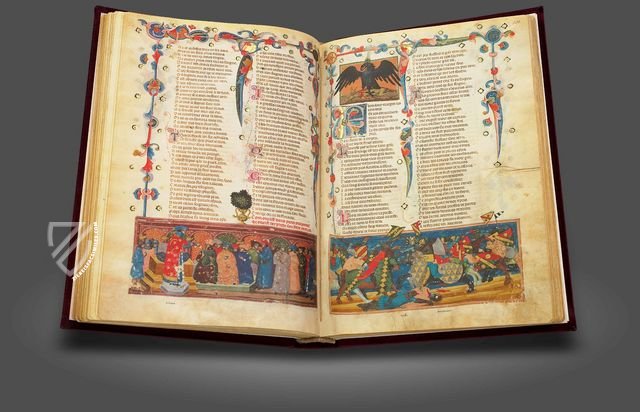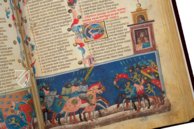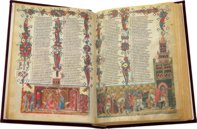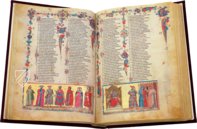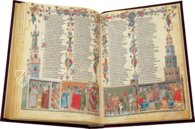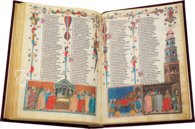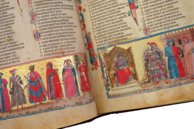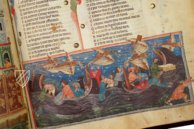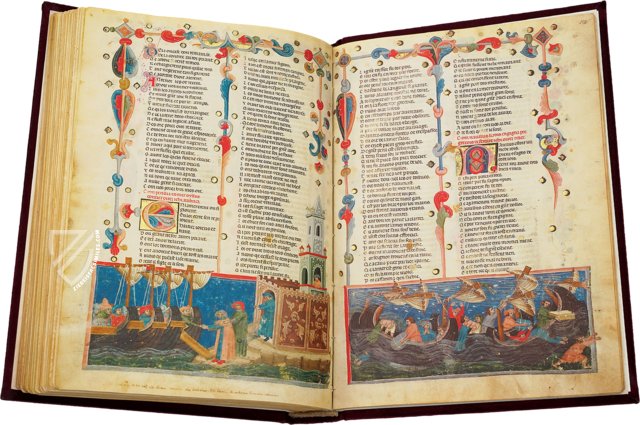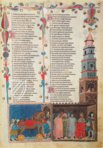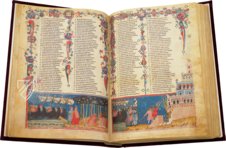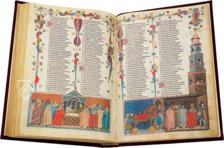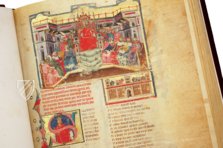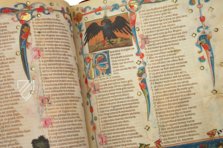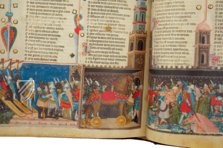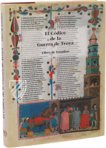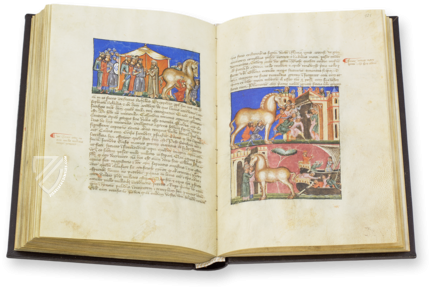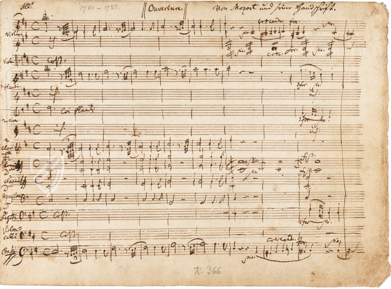St. Petersburg Roman de Troie
(3,000€ - 7,000€)
The epic history of the Trojan War has inspired artists, authors and directors for centuries. One of the most artistic adaptations of the mythological material was created in the Italian city of Bologna in the 14th century by a virtuoso but anonymous illuminator. The so-called Petersburg Codex of the Roman de Troie is based on the literary model by the French author Benoît de Sainte-Maure (d. 1173), which he originally wrote between 1160 and 1170 for Henry II Plantagenet and his wife Queen Eleanor of Aquitaine, and is decorated with 341 breathtaking illuminations. The expressive and dynamic bas-de-page illuminations, whose architecture often extends into the margins of the pages, illustrate the dramatic events of the ancient myth and are also a charming source on medieval life during the Italian Trecento.
Codice de la Guerra de Troya
The mythological tale of the Trojan War is undoubtedly one of the most influential and repeated legends of all time. It has been continuously adapted, the most recent example being Oliver Stone’s blockbuster “Troy” with Brad Pitt and Orlando Bloom as the leads. The timeless saga has also been reworked countless times in literature. The French author Benoît de Sainte-Maure committed himself to the ancient material between 1155 and 1160. In doing so, he completed one of the most significant literary versions of the epic, which was cited and reworked throughout the entire Middle Ages. In the second half of the 14th century, the Frenchman’s masterpiece was adapted by an anonymous Italian illuminator, who created one of the most astounding illuminated manuscripts in the history of medieval illumination from this famous example. The manuscripts is an unbelievably richly furnished picture book with artful and historically informative miniatures on practically every page.
Benoît de Sainte-Maure’s Romance of Troy
Benoît de Sainte-Maure was a French-speaking author who lived and worked in the County of Touraine in the middle of the 12th century. His most famous work was the Romance of Troy, completed between 1160 and 1170 for King Henry II of England and Queen Eleanor of Aquitaine. Their court was one of the most important intellectual and cultural centers of the medieval world, and as was common among the intellectual nobility of their time, only French was spoken here. For his material template, Sainte-Maure employed not only Homer’s famous epic – The Illiad (which was only known through hearsay in Western Europe at that time) – but also two from two depictions supposedly composed by eyewitness of the Trojan War. In doing so, it deals with the descriptions of Dictys Cretensis, who experienced things from the Greek side, as well as the tale of Dares Phrygius, who was purported to be in Troy at the time. However, Benoit only took over the rough parameters from Dictys and Dares, which he fancifully furnished with love stories, chivalric battle scene, and scholarly excursions.
The Italian Adaptation of the Masterpiece
Benoît de Sainte-Maure’s The Romance of Troy was, as mentioned earlier, copied in Italy in the 14th century and furnished with a rich miniature cycle. From the beginning, France, with its troubadours, epics, and court poetry, had assumed a leading position in the development of vernacular literature of Europe. French literature was the example and trailblazer, its works were translated, imitated, reworked and rearranged. French literature played an especially big role in urban centers like Bologna and Venice. The Italian version of The Romance of Troy was also most likely produced in Bologna. The 3000+ verse literary monument from France was not only reproduced in its original language, the real accomplishment of the anonymous adaptor lays in the illustrations of the ancient saga. The picture cycle of the Italian The Romance of Troybelongs among the most outstanding ever created in the history of illumination.
An Impressive Miniature Cycle
The impressive miniatures of the Italian version of The Romance of Troy puts the tale’s individual moments of action so clearly in the limelight, that the events can be completely understood without text by means of the illustrations. However, the events related in the text are not exclusively presented pictorially. The spontaneous narrative pleasure of the authors also shows itself equally in the small embellishing details and anecdotes that do not occur in the story. A particularly attractive example for the unbelievably lifelike and vivid illumination is a completely unusual depiction of the shipwrecked Ajax and his companions. Some of the castaways in the picture cower shivering on the rocky island, on which they have taken refuge, others laboriously swim to the shore, still more lie drowned in the water. Never before has an illuminator managed to design pictures of such drama and expressivity. The miniatures of the precious manuscript need not eschew comparison with the great works of the Italian painters. Some of the miniatures artfully exhibit everyday objects as they appeared in 14th century Italy. Typical Italian architectural features are portrayed, along with furniture of the like that would be found in Italian homes, and typical garments and costumes. The pictures of the The Romance of Troy distinguish themselves not only because of their graceful beauty. By the same token, they represent an extremely interesting, historically-significant source about life in medieval Italy.
Codicology
- Alternative Titles
- Le Roman de Troie
History of the Trojan War
Geschichte des Trojanischen Kriegs
Le Roman de la Guerre de Troya
Códice de la Guerra de Troya
Romance of Troy - Size / Format
- 336 pages / 41.5 × 28.0 cm
- Origin
- Italy
- Date
- Second half of the 14th century
- Epochs
- Style
- Language
- Script
- Gothic Textura Rotunda
- Illustrations
- 341 miniatures, most of them bas-de-page illuminations; 4 historiated initials, 56 large ornamental initials; borders on almost every page
- Content
- History of the Trojan War according to Benoît de Sainte-Maure
- Artist / School
- Benoît de Sainte-Maure (d. 1173) (author)
Bolognese School (illuminators) - Previous Owners
- Pierre Séguier
Abbey of Saint-Germain-des-Prés
Peter P. Dubrovsky
Imperial Public Library, St. Petersburg
Codice de la Guerra de Troya
Cavalry Battle
The Trojan War was used by medieval artists to depict contemporary court life and idealized stories of chivalry. This miniature showing the Greeks and Trojans fighting as heavy cavalry is a perfect example because it is a style of warfare that would have been virtually unknown to Bronze Age Greeks. With lances firmly couched under their arms and making use of stirrups, a high medieval cavalry battle unfolds here as the ladies of Troy look down anxiously from the towers of the city.

Codice de la Guerra de Troya
Procession of the Trojan Horse
Although most people today would think of a malicious computer program, here we have an artful depiction of the actual Trojan Horse in this splendid bas-de-page miniature. Soldiers with helmets of silver and gold push and pull the wheeled horse, which is outfitted with bells and a brilliant red saddle. Trumpeters announce the procession as it enters the doomed city of Troy.
King Priam is depicted inside the gate dressed in contemporary garments, as are his counselors and bodyguards, including metal greaves, which were common pieces of both antique and late medieval armor. The tower stretching upward is full of curious citizens looking and pointing at the treacherous gift. Multicolored marginalia and circles of gold leaf fill the rest of the page.
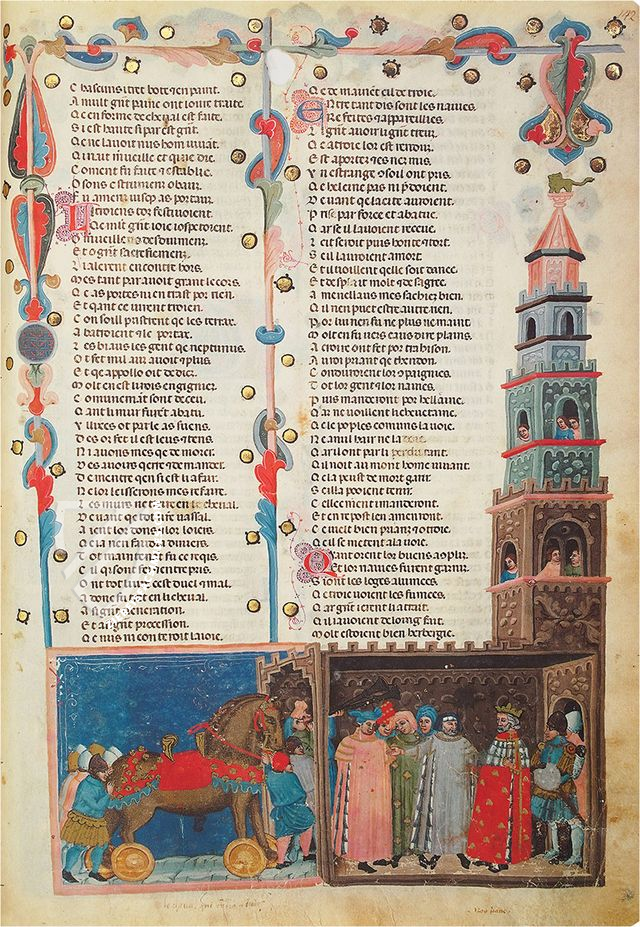
#1 Codice de la Guerra de Troya
Language: Spanish
(3,000€ - 7,000€)
- Treatises / Secular Books
- Apocalypses / Beatus
- Astronomy / Astrology
- Bestiaries
- Bibles / Gospels
- Chronicles / History / Law
- Geography / Maps
- Saints' Lives
- Islam / Oriental
- Judaism / Hebrew
- Single Leaf Collections
- Leonardo da Vinci
- Literature / Poetry
- Liturgical Manuscripts
- Medicine / Botany / Alchemy
- Music
- Mythology / Prophecies
- Psalters
- Other Religious Books
- Games / Hunting
- Private Devotion Books
- Other Genres
- Afghanistan
- Armenia
- Austria
- Belgium
- Belize
- Bosnia and Herzegovina
- China
- Colombia
- Costa Rica
- Croatia
- Cyprus
- Czech Republic
- Denmark
- Egypt
- El Salvador
- Ethiopia
- France
- Germany
- Greece
- Guatemala
- Honduras
- Hungary
- India
- Iran
- Iraq
- Israel
- Italy
- Japan
- Jordan
- Kazakhstan
- Kyrgyzstan
- Lebanon
- Liechtenstein
- Luxembourg
- Mexico
- Morocco
- Netherlands
- Palestine
- Panama
- Peru
- Poland
- Portugal
- Romania
- Russia
- Serbia
- Spain
- Sri Lanka
- Sweden
- Switzerland
- Syria
- Tajikistan
- Turkey
- Turkmenistan
- Ukraine
- United Kingdom
- United States
- Uzbekistan
- Vatican City
- A. Oosthoek, van Holkema & Warendorf
- Aboca Museum
- Ajuntament de Valencia
- Akademie Verlag
- Akademische Druck- u. Verlagsanstalt (ADEVA)
- Aldo Ausilio Editore - Bottega d’Erasmo
- Alecto Historical Editions
- Alkuin Verlag
- Almqvist & Wiksell
- Amilcare Pizzi
- Andreas & Andreas Verlagsbuchhandlung
- Archa 90
- Archiv Verlag
- Archivi Edizioni
- Arnold Verlag
- ARS
- Ars Magna
- ArtCodex
- AyN Ediciones
- Azimuth Editions
- Badenia Verlag
- Bärenreiter-Verlag
- Belser Verlag
- Belser Verlag / WK Wertkontor
- Benziger Verlag
- Bernardinum Wydawnictwo
- BiblioGemma
- Biblioteca Apostolica Vaticana (Vaticanstadt, Vaticanstadt)
- Bibliotheca Palatina Faksimile Verlag
- Bibliotheca Rara
- Boydell & Brewer
- Bramante Edizioni
- Bredius Genootschap
- Brepols Publishers
- British Library
- C. Weckesser
- Caixa Catalunya
- Canesi
- CAPSA, Ars Scriptoria
- Caratzas Brothers, Publishers
- Carus Verlag
- Casamassima Libri
- Centrum Cartographie Verlag GmbH
- Chavane Verlag
- Christian Brandstätter Verlag
- Circulo Cientifico
- Club Bibliófilo Versol
- Club du Livre
- CM Editores
- Collegium Graphicum
- Collezione Apocrifa Da Vinci
- Comissão Nacional para as Comemorações dos Descobrimentos Portugueses
- Coron Verlag
- Corvina
- CTHS
- D. S. Brewer
- Damon
- De Agostini/UTET
- De Nederlandsche Boekhandel
- De Schutter
- Deuschle & Stemmle
- Deutscher Verlag für Kunstwissenschaft
- DIAMM
- Droz
- E. Schreiber Graphische Kunstanstalten
- Ediciones Boreal
- Ediciones Grial
- Ediclube
- Edições Inapa
- Edilan
- Editalia
- Edition Deuschle
- Edition Georg Popp
- Edition Leipzig
- Edition Libri Illustri
- Editiones Reales Sitios S. L.
- Éditions de l'Oiseau Lyre
- Editions Medicina Rara
- Editorial Casariego
- Editorial Mintzoa
- Editrice Antenore
- Editrice Velar
- Edizioni Edison
- Egeria, S.L.
- Eikon Editores
- Electa
- Emery Walker Limited
- Enciclopèdia Catalana
- Eos-Verlag
- Ephesus Publishing
- Ernst Battenberg
- Eugrammia Press
- Extraordinary Editions
- Fackelverlag
- Facsimila Art & Edition
- Facsimile Editions Ltd.
- Facsimilia Art & Edition Ebert KG
- Faksimile Verlag
- Feuermann Verlag
- Folger Shakespeare Library
- Franco Cosimo Panini Editore
- Friedrich Wittig Verlag
- Fundación Hullera Vasco-Leonesa
- G. Braziller
- Gabriele Mazzotta Editore
- Gebr. Mann Verlag
- Gesellschaft für graphische Industrie
- Getty Research Institute
- Giovanni Domenico de Rossi
- Giunti Editore
- Graffiti
- Grafica European Center of Fine Arts
- Guido Pressler
- Guillermo Blazquez
- Gustav Kiepenheuer
- H. N. Abrams
- Harrassowitz
- Harvard University Press
- Helikon
- Hendrickson Publishers
- Henning Oppermann
- Herder Verlag
- Hes & De Graaf Publishers
- Hoepli
- Holbein-Verlag
- Houghton Library
- Hugo Schmidt Verlag
- Idion Verlag
- Il Bulino, edizioni d'arte
- ILte
- Imago
- Insel Verlag
- Instituto de Estudios Altoaragoneses
- Instituto Nacional de Antropología e Historia
- Istituto dell'Enciclopedia Italiana - Treccani
- Istituto Ellenico di Studi Bizantini e Postbizantini
- Istituto Geografico De Agostini
- Istituto Poligrafico e Zecca dello Stato
- Italarte Art Establishments
- Jan Thorbecke Verlag
- Johnson Reprint Corporation
- Josef Stocker
- Josef Stocker-Schmid
- Jugoslavija
- Karl W. Hiersemann
- Kasper Straube
- Kaydeda Ediciones
- Kindler Verlag / Coron Verlag
- Kodansha International Ltd.
- Konrad Kölbl Verlag
- Kurt Wolff Verlag
- La Liberia dello Stato
- La Linea Editrice
- La Meta Editore
- Lambert Schneider
- Landeskreditbank Baden-Württemberg
- Leo S. Olschki
- Les Incunables
- Liber Artis
- Library of Congress
- Libreria Musicale Italiana
- Lichtdruck
- Lito Immagine Editore
- Lumen Artis
- Lund Humphries
- M. Moleiro Editor
- Maison des Sciences de l'homme et de la société de Poitiers
- Manuscriptum
- Martinus Nijhoff
- Maruzen-Yushodo Co. Ltd.
- MASA
- Massada Publishers
- McGraw-Hill
- Metropolitan Museum of Art
- Militos
- Millennium Liber
- Müller & Schindler
- Nahar - Stavit
- Nahar and Steimatzky
- National Library of Wales
- Neri Pozza
- Nova Charta
- Oceanum Verlag
- Odeon
- Orbis Mediaevalis
- Orbis Pictus
- Österreichische Staatsdruckerei
- Oxford University Press
- Pageant Books
- Parzellers Buchverlag
- Patrimonio Ediciones
- Pattloch Verlag
- PIAF
- Pieper Verlag
- Plon-Nourrit et cie
- Prestel Verlag
- Princeton University Press
- Prisma Verlag
- Priuli & Verlucca, editori
- Pro Sport Verlag
- Propyläen Verlag
- Pytheas Books
- Quaternio Verlag Luzern
- Reales Sitios
- Recht-Verlag
- Reichert Verlag
- Reichsdruckerei
- Reprint Verlag
- Riehn & Reusch
- Roberto Vattori Editore
- Rosenkilde and Bagger
- Roxburghe Club
- Salerno Editrice
- Saltellus Press
- Sandoz
- Sarajevo Svjetlost
- Schöck ArtPrint Kft.
- Schulsinger Brothers
- Scolar Press
- Scrinium
- Scripta Maneant
- Scriptorium
- Shazar
- Siloé, arte y bibliofilia
- SISMEL - Edizioni del Galluzzo
- Sociedad Mexicana de Antropología
- Société des Bibliophiles & Iconophiles de Belgique
- Soncin Publishing
- Sorli Ediciones
- Stainer and Bell
- Studer
- Styria Verlag
- Sumptibus Pragopress
- Szegedi Tudomànyegyetem
- Taberna Libraria
- Tarshish Books
- Taschen
- Tempus Libri
- Testimonio Compañía Editorial
- Thames and Hudson
- The Clear Vue Publishing Partnership Limited
- The Facsimile Codex
- The Folio Society
- The Marquess of Normanby
- The Richard III and Yorkist History Trust
- Tip.Le.Co
- TouchArt
- TREC Publishing House
- TRI Publishing Co.
- Trident Editore
- Typis Regiae Officinae Polygraphicae
- Union Verlag Berlin
- Universidad de Granada
- University of California Press
- University of Chicago Press
- Urs Graf
- Vallecchi
- Van Wijnen
- VCH, Acta Humaniora
- VDI Verlag
- VEB Deutscher Verlag für Musik
- Verlag Anton Pustet / Andreas Verlag
- Verlag Bibliophile Drucke Josef Stocker
- Verlag der Münchner Drucke
- Verlag für Regionalgeschichte
- Verlag Styria
- Vicent Garcia Editores
- W. Turnowski Ltd.
- W. Turnowsky
- Waanders Printers
- Wiener Mechitharisten-Congregation (Wien, Österreich)
- Wissenschaftliche Buchgesellschaft
- Wissenschaftliche Verlagsgesellschaft
- Wydawnictwo Dolnoslaskie
- Xuntanza Editorial
- Zakład Narodowy
- Zollikofer AG

